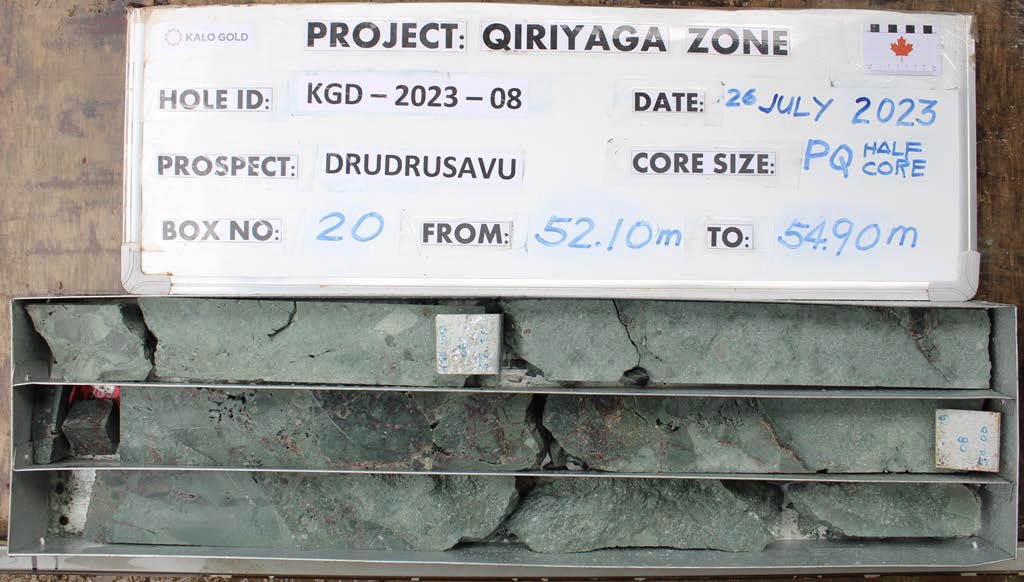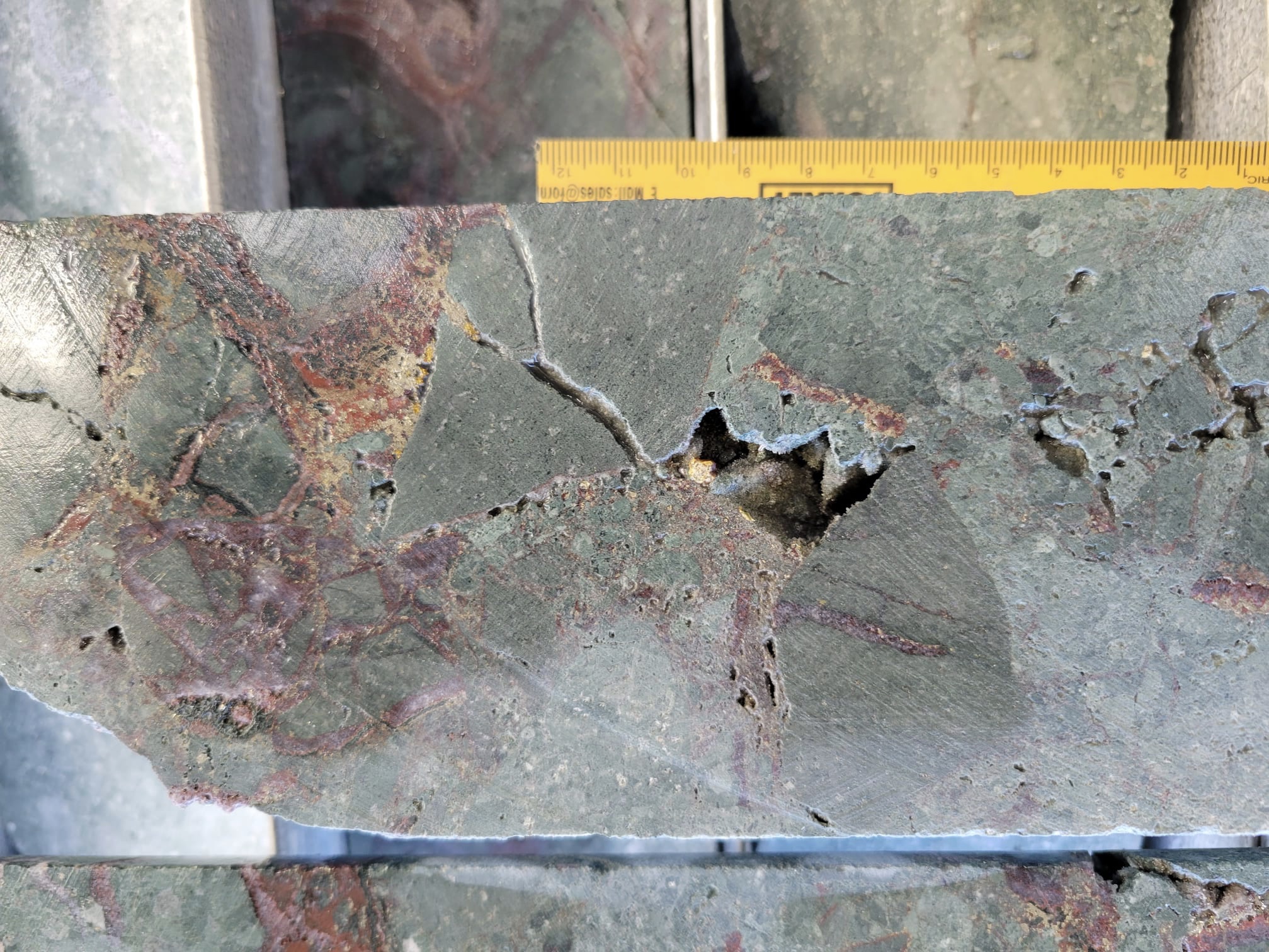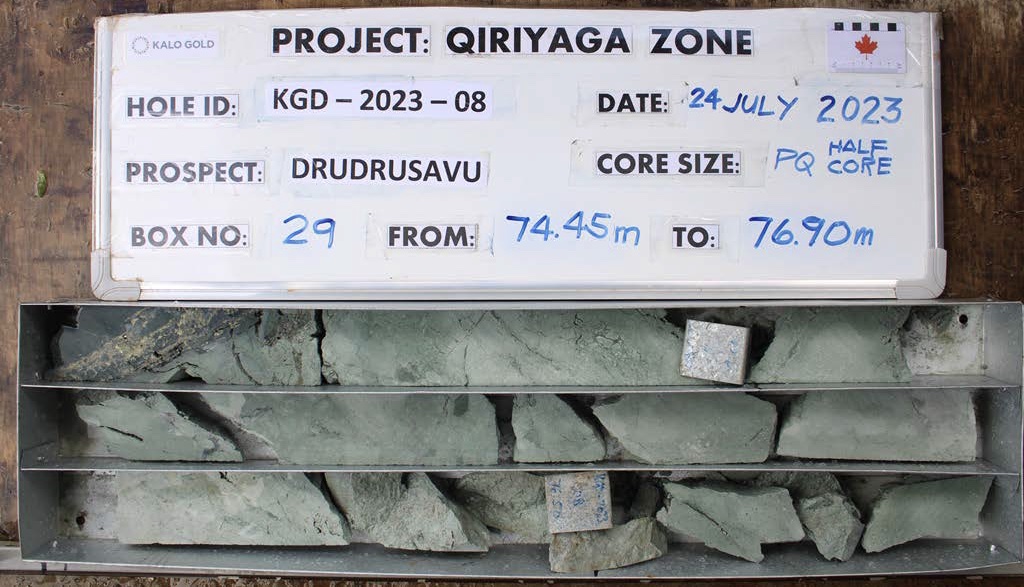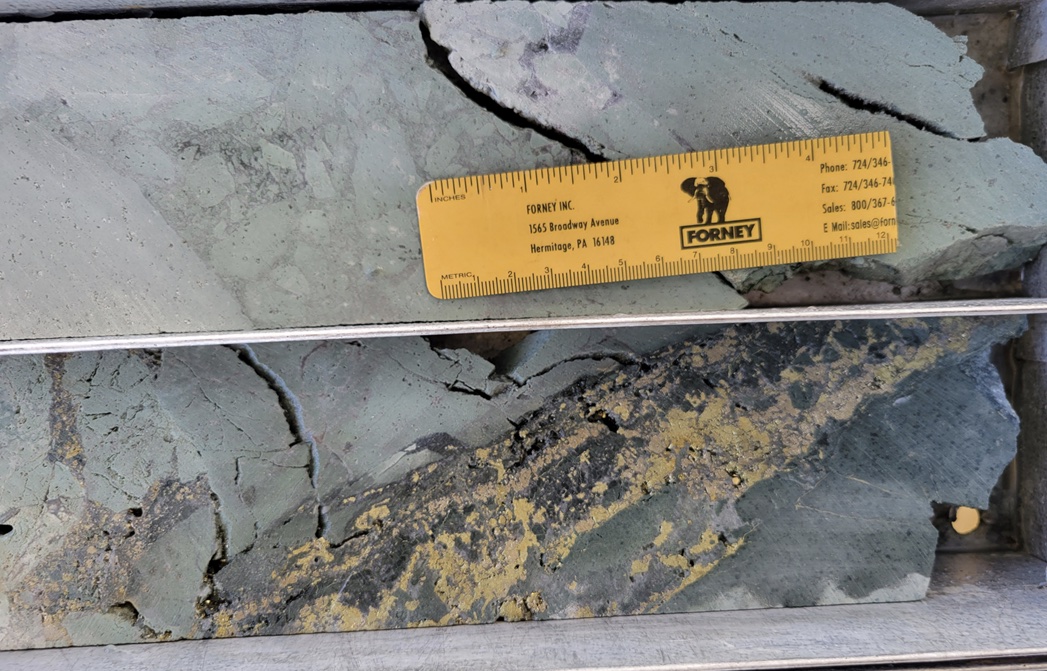Release Highlights:
- Drilling at Drudrusavu has discovered a new epithermal vein system two kilometers east of the Qiriyaga Hill and Vuinubu Ridge Gold Deposits clearly associated with a prominent CSAMT high resistivity anomaly.
- Drudrusavu mineralization is associated with at least two stages of epithermal mineralization, characterized by the presence of quartz sulfide veinlets and hydrothermal alteration, that have been documented over three intervals totaling 87.1 meters in KGD-2023-08 and 65.0 meters in KDG-2023-09.
- Drilling at Mouta Prospect intersected two styles of mineralization primarily consisting of a broad zone of multi-directional epithermal sulfide veinlets consisting of zinc sulfides including sphalerite and marmatite, pyrite, and minor chalcopyrite with some caldera margin related shear-style mineralization.
VANCOUVER, BRITISH COLUMBIA, CANADA: 27 SEPTEMBER 2023, KALO GOLD CORP. (“Kalo”, “Kalo Gold” or the “Company”) is pleased to provide an update on the exploration program at Vatu Aurum Gold Project (“Vatu Aurum” or the “Project”), Republic of Fiji. Kalo has completed four diamond drill holes in the 2023 exploration program: two at Drudrusavu (“Drudrusavu”) located within the Qiriyaga Hill Prospect (“Qiriyaga”) and two at Mouta Prospect (“Mouta”) for a total of 432.0 meters (“m”).
Mr. Terry L Tucker, P.Geo, President and CEO of Kalo Gold, commented “The two drill holes at Drudrusavu successfully confirmed the Controlled-Source Audio-frequency Magnetotellurics (“CSAMT”) geophysical survey has identified zones of hydrothermal alteration and silicification. Both holes drilled had between 65 and 87 m of silicification and hydrothermal alteration and that included one interval that returned 4 meters averaging 1.23 g/t Au and 1 metre averaging 4.17 g/t Au. Given the shallow level of erosion that has been interpreted this indicates there is excellent potential for mineralization at depth at Drudrusavu. The positive correlation between the CSAMT and the drilling at Drudrusavu will give us the confidence to expand exploration at Qiriyaga. Previous drill results at Qiriyaga intersected thick, near-surface, high-grade gold mineralization, particularly drill hole KCD-17 that returned 8.75 metres at 36.02 g/t Au (61.25 to 70 m) and 10 m at 27.18 g/t Au (76-86 m) including 120 g/t Au between 81 to 82 m.”
Drudrusavu
Two holes, KGD-2023-08 (232.50m) and KGD-2023-09 (169.50m) were drilled at Drudrusavu which is located 2 km east of Qiriyaga Hill and Vuinubu Ridge Gold Deposits. The drainage through Drudrusavu contained a “very strong gold anomaly” with gold in the stream sediment samples returning up to 580 parts per billion (“ppb”) gold. Drudrusavu was originally defined by a 750 m long multi element soil and rock geochemical anomaly that was subsequently drilled in 1986 by Placer Dome. Drill holes KGD-2023-08 and KGD-2023-09 successfully tested the down dip extent of mineralized outcrop on Drudrusavu Creek, the soil geochemical anomaly, historical drilling and a prominent resistivity anomaly defined by a recently completed CSAMT survey (Target 5 in the previous release). The resistivity anomaly is believed to correspond to a ring fault around the edge of a caldera, a potential fertile corridor for precious metals mineralization (Figures 1 and 2).
KGD-2023-08 intersected three mineralized zones from 50.4 to 85.5m, 115.5 to 157.5m and 206.1 to 216.1m composed of millimetre wide quartz veinlets with anhedral and open-space (comb) textures hosted in silica-chlorite altered polymictic breccia and dacite. Gold mineralization was intersected over a 4m zone averaging 1.23 grams per tonne (“g/t”) gold, including a meter sample grading 4.17 g/t gold (see Table 1 and Photos 1 to 4).
KGD-2023-09 was drilled 100m to the southeast of KGD-2023-09 along the same CSAMT resistivity anomaly. It intersected three mineralized zones from 41.2 to 59.8m, 72.2 to 105.0m and 114.9 to 128.4m consisting of mm-wide quartz veinlets with comb texture associated with fine pyrite and chalcopyrite hosted in the same rock and alteration suite as KGD-2023-09.
Drill ID | From (m) | To (m) | Interval (m) | Gold (g/t) | Silver (g/t) | Copper (%) | Zinc (%) |
KGD-2023-08 | 53.0 | 57.0 | 4.0 | 1.23 | – | – | – |
Including | 53.0 | 54.0 | 1.0 | 4.17 | – | – | – |
And | 74.0 | 75.0 | 1.0 | – | – | 1.54 | – |
And | 207.0 | 208.0 | 1.0 | – | – | 0.22 | – |
KGD-2023-09 | 99.0 | 105.0 | 6.0 | – | – | 0.23 | 0.35 |
Including | 103.0 | 104.0 | 1.0 | – | – | 0.68 | 0.53 |
And | 124.0 | 130.0 | 6.0 | – | – | 0.21 | – |
Drill ID | From (m) | To (m) | Interval (m) | Gold (g/t) |
Placer Dome FDD-1986-03 | 36 | 76 | 40 | 0.6 |
Including | 36 | 46 | 10 | 1.78 |
Including | 40 | 44 | 4 | 3.78 |
Table 1: Drudrusavu Drill Results
The gold mineralization at Drudrusavu as shown in these two drill holes is associated with at least two stages of quartz veinlets.
- Early-stage quartz veinlets and breccia filling with anhedral texture and a homogeneous appearance and an absence of banding, open-space, or similar features. This type of quartz generally infills the space between clasts of brecciated dacite. No other sulfides except pyrite have been documented with it.
- A later-stage event with quartz veinlets-pyrite-chalcopyrite (centerline), was observed to cut the early quartz and is characterized by a cockscomb, open-space texture.
The relatively shallow oxidation level (~10m) at Drudrusavu suggests that the mineralization in the area will generally be primary. The results of the Drudrusavu drilling in addition to confirming gold mineralization in that area has extended the extent of the Qiriyaga Prospect a total of 2 km. The mineralization remains open along strike to the northeast and southeast and importantly at depth and correlates well with the CSAMT resistivity anomaly 5 as illustrated in Figure 3.
Mouta Prospect
Mouta Prospect (“Mouta”) is located approximately 9 km northwest of Qiriyaga Hill Prospect on the outer edge of the Mouta Caldera. Two holes, KMD-2023-01 (151.5m) and KMD-2023-02 (280.5m) were drilled at Mouta to test a 330m long NE-trending soil anomaly characterized by coincident Au-Ag-As-Sb-Hg-Cu-Pb-Zn and a strong Induced Polarization (“IP”) signature (see Figure 4).
Two styles of mineralization were intersected, the first is the shear-style mineralized zone and the second is the broad zone of multi-directional epithermal sulfide veinlets consisting of zinc sulfides including sphalerite and marmatite, pyrite, and minor chalcopyrite. The mineralization is interpreted to be related to shallowly eroded phreatomagmatic eruption setting like the other Prospects on the Property.
KMD-2023-01 intersected the shear style mineralization from 31.0 to 51.0m hosted in a dark gray dacite breccia. It is gougy and strongly silicified in some sections with pyrite, chalcopyrite, and zinc sulfides (marmatite and sphalerite) up to 10% volume occurring as veinlets and disseminations. This zone is the downdip expression of the mineralized outcrop observed at the surface.
The second style of mineralization was intersected from 51.0 to 69.0m in an intensely clay altered, felsic dacite breccia. The frequency of these veinlets is generally 5 to 10 per m and total sulfides are estimated between 5% to 7% volume. This zone was disrupted by an 8.40m, barren dark grey colored andesite dike from 68.2 to 76.6m but continued again until 94.0m. Mineralization tapered off from 94.0m downwards until a barren dacite flow (country rock) was hit at 117.80m.
KMD-2023-02 intersected the shear style mineralization from 30.55 to 45.30m within a highly oxidized zone that extends down to a depth of 59.40m. It intersected several 2m copper-bearing zones grading between 0.27% – 0.39% Cu with up to 3.56% Zn.
The second style of mineralization was intersected from 129.5 to 178.0m. This zone is hosted within a silica – clay – chlorite altered dacite breccia from 129.50 m to 151.0m, and intense clay alteration from 151.0 to 178.0m. The sulfides identified within this zone are pyrite, zinc sulfides, and chalcopyrite and estimated to be up to 10%. KMD-2023-02 is mineralized from 178.0 m down to the end of hole at 280.5 m, but only pyrite was identified occurring both as fracture filling and disseminations in an intensely clay-altered dacite breccia. It returned 4 m averaging 0.59% from 167-171m.
Drill ID | From (m) | To (m) | Interval (m) | Gold (g/t) | Silver (g/t) | Copper (%) | Zinc (%) |
KMD-2023-01 | 31.0 | 69.0 | 38.0 | – | – | 976 ppm | 1.19% |
Including | 33.0 | 35.0 | 2.0 | – | 7.81 | 0.27% | 0.61% |
Including | 34.0 | 39.0 | 5.0 | – | 33.74 | 623 ppm | 2.12% |
Including | 38.0 | 40.0 | 2.0 | – | 12.67 | 0.39% | 3.56% |
Including | 46.0 | 49.0 | 3.0 | – | – | 0.37% | 0.73% |
and | 76.6 | 94.0 | 17.4 | – | – | – | 0.91% |
KMD-2023-02 | 66.0 | 177.0 | 66.5 | – | – | – | 0.41% |
Including | 131.0 | 139.0 | 8.0 | 0.15 | – | – | 1.13% |
Including | 131.0 | 157.0 | 26.0 | – | – | 774 ppm | 0.85% |
Including | 167.0 | 171.0 | 4.0 | – | – | 0.59% | 0.45% |
Table 2: Mouta Drill Results
Mouta Prospect – Surface Channel Sample Results
Surface mapping has identified zones of silica, silica-clay, and clay alteration and the host rock of gold mineralization is a clay altered pumiceous dacite breccia. Argillic alteration can be intense locally and the main minerals are pyrite, sphalerite, chalcopyrite, chalcocite and barite. The presence of gold-silver-copper mineralization at Mouta Prospect, including: 6.2g/t Au, 645g/t Ag and 3.12% Cu from rock chip outcrop sampling and 3.06g/t Au, 819g/t Ag and 1.63% Cu from a stockpile grab sample have been received in addition to recently completed surface channel sampling of the mineralized outcrop. The table below summarizes the gold results from the channel sampling:
Channel No. | From (m) | To (m) | Interval (m) | Gold (g/t) |
MT-2022-01 | 0 | 3 | 3 | 0.42 |
3 | 6 | 3 | 1.29 | |
6 | 8 | 2 | 1.59 | |
Average | 8 | 1.04 | ||
MT-2022-02 | 0 | 2 | 2 | 3.75 |
2 | 4 | 2 | 2.82 | |
Average | 4 | 3.28 | ||
MT-2022-03 | 0 | 2 | 2 | 1.98 |
2 | 4 | 2 | 2.45 | |
Average | 4 | 2.22 | ||
MT-2022-04 | 0 | 2.7 | 2.7 | 2.48 |
Table 3: Mouta Surface Channel Sample Results
The results of the work so far done in Mouta, including the two recently completed drill holes, has demonstrated that Mouta offers an opportunity for a gold or a gold-copper-zinc discovery. The Company will continue to evaluate the results for an effective follow up exploration program.
Sampling, Analysis and QAQC
The drill core was sampled at 1m intervals and cut into half with an electric core saw at the at the Company’s exploration camp. The core samples were submitted to ALS Minerals laboratory in Brisbane, Australia (“ALS”) for sample preparation and analysis. The gold was analyzed using Au-AA24 method (50g split). Multi-element analysis was also carried out using ME-ICP61m method. Kalo’s Quality Control and Quality Assurance (QAQC) protocol for drill core samples includes: 1) field measurement of half core sample weights, 2) insertion of certified reference materials at 1 in 20 frequencies, 3) insertion of blank sample at 1 in 40 frequencies, and 3) insertion of duplicate core samples. ALS has internal QAQC protocols that include analysis and results monitoring for certified reference materials, blank samples, and duplicate core samples.
ABOUT KALO GOLD CORP.
Kalo Gold Corp, a gold exploration company, is focused on exploration for low sulphidation epithermal gold deposits of the Vatu Aurum Gold Project on the island of Vanua Levu (North Island) in the Republic of Fiji. Kalo holds a 100% interest in two Special Prospecting Licenses, covering 367 km2 that hosts a minimum of seven volcanic arc related calderas ranging between 1 to 10km in diameter in a geological setting that could be analogous to the alkaline related low sulphidation epithermal gold deposits of both the neighbouring Vatukoula Gold Mine and the Lion One Metals’ Tuvatu Alkaline Gold Project. Historical exploration work concentrated on the Qiriyaga Hill and Vuinubu Ridge Gold Deposits and resulted in the identification of over fourteen priority epithermal gold exploration targets.
Both Viti Levu, (South Island), and Vanua Levu are on the prolific Pacific “Ring of Fire”, a trend that has produced numerous large deposits, including Porgera, Lihir and Grasberg and on Viti Levu, the exceptional Vatukoula Gold Mine. The Vatukoula Gold Mine has produced more than 7 million ounces of gold since 1937. The island of Viti Levu also hosts the fully permitted Tuvatu Alkaline Gold Project, where Lion One Metals is fast tracking a high-grade underground gold mining operation.
Qualified Person
The technical disclosure in this news release has been approved by Terry L. Tucker, P.Geo. a Qualified Person as defined by National Instrument 43-101 of the Canadian Securities Administrators.
On behalf of the Board of Directors of Kalo Gold Corp.
Terry L. Tucker, P.Geo
President and Chief Executive Officer
and
Kevin Ma, CPA, CA
Executive Vice President, Capital Markets and Director
For more information, please write to info@kalogoldcorp.com.
Neither the TSX Venture Exchange nor its Regulation Services Provider (as that term is defined in the policies of the Exchange) accepts responsibility for the adequacy or accuracy of this press release.
Forward Looking Statements Disclaimer
Certain statements in this release are forward-looking statements, which are statements that are not purely historical, including any statements regarding beliefs, plans, expectations, or intentions regarding the future. Forward looking statements in this news release include statements relating to the Company’s proposed drilling timeline and the proposed expansion of the exploration program, and the Company’s plans for future exploration on the Vatu Aurum Gold Project. Forward-looking statements are often identified by terms such as “will”, “may”, “should”, “anticipate”, “expects” and similar expressions. All statements included in this news release, other than statements of historical fact, are forward-looking statements that involve risks and uncertainties. There can be no assurance that such statements will prove to be accurate and actual results, and future events could differ materially from those anticipated in such statements. Important factors that could cause actual results to differ materially from the Company’s expectations include quality and quantity of any mineral deposits that may be located, the Company’s inability to obtain any necessary permits, consents or authorizations required for its activities, the Company’s inability to raise the necessary capital to be fully able to implement its business strategies, and other risks and uncertainties disclosed in the Company’s filing statement dated February 9, 2021 and latest interim Management Discussion and Analysis filed with certain securities commissions in Canada.
The reader is cautioned that assumptions used in the preparation of any forward-looking statements herein may prove to be incorrect. Events or circumstances may cause actual results to differ materially from those predicted, as a result of numerous known and unknown risks, uncertainties, and other factors, many of which are beyond the control of the Company. The reader is cautioned not to place undue reliance on any forward-looking information. Such information, although considered reasonable by management at the time of preparation, may prove to be incorrect, and actual results may differ materially from those anticipated. Forward-looking statements contained in this news release are expressly qualified by this cautionary statement. The forward-looking statements contained in this news release are made as of the date of this news release and the Company will update or revise publicly any of the included forward-looking statements as expressly required by Canadian securities law.
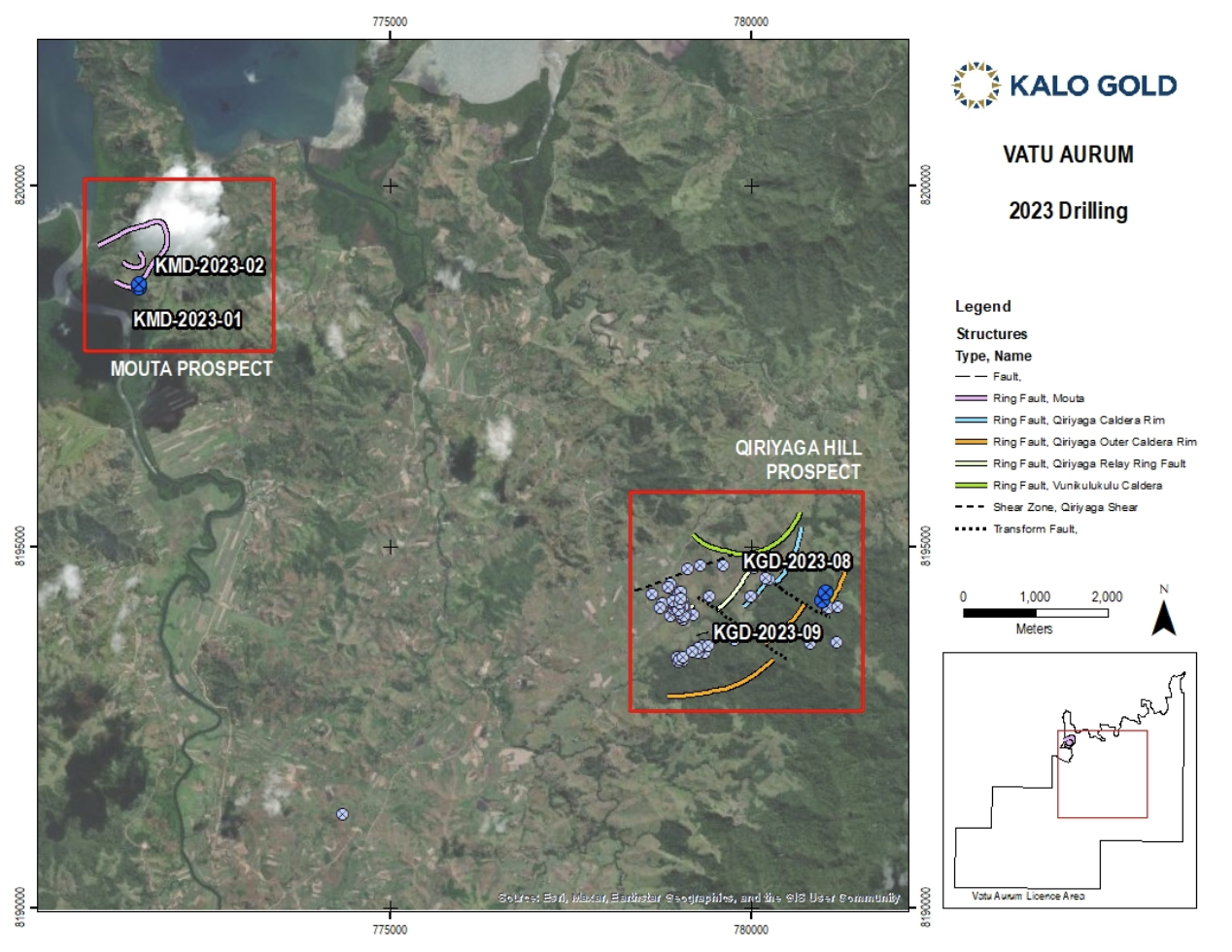
Figure 1: Vatu Aurum Gold Project – 2023 drilling to date (blue circles) at Mouta and Qiriyaga Hill Prospects.
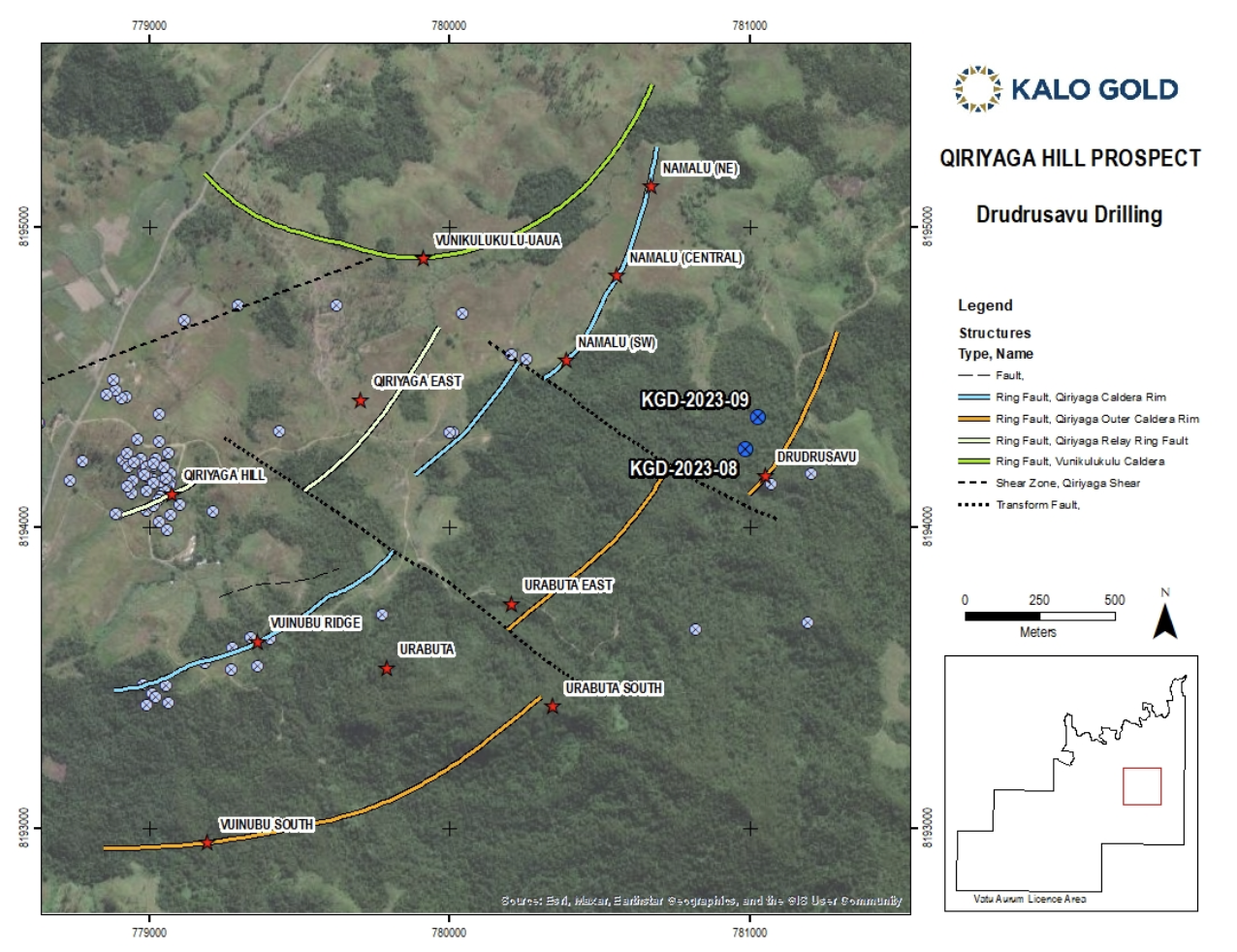
Figure 2: Vatu Aurum Gold Project – 2023 drilling to date (blue circles) at Qiriyaga Hill Prospect.

Figure 3: Qiriyiga Hill Prospect – CSAMT 1D Inversion at 200 meters with six key target zones identified.

*Note: Electrical resistivity is a measure of a material’s property to oppose the flow of electric current. This is expressed in Ohm-meters (Ω⋅m).
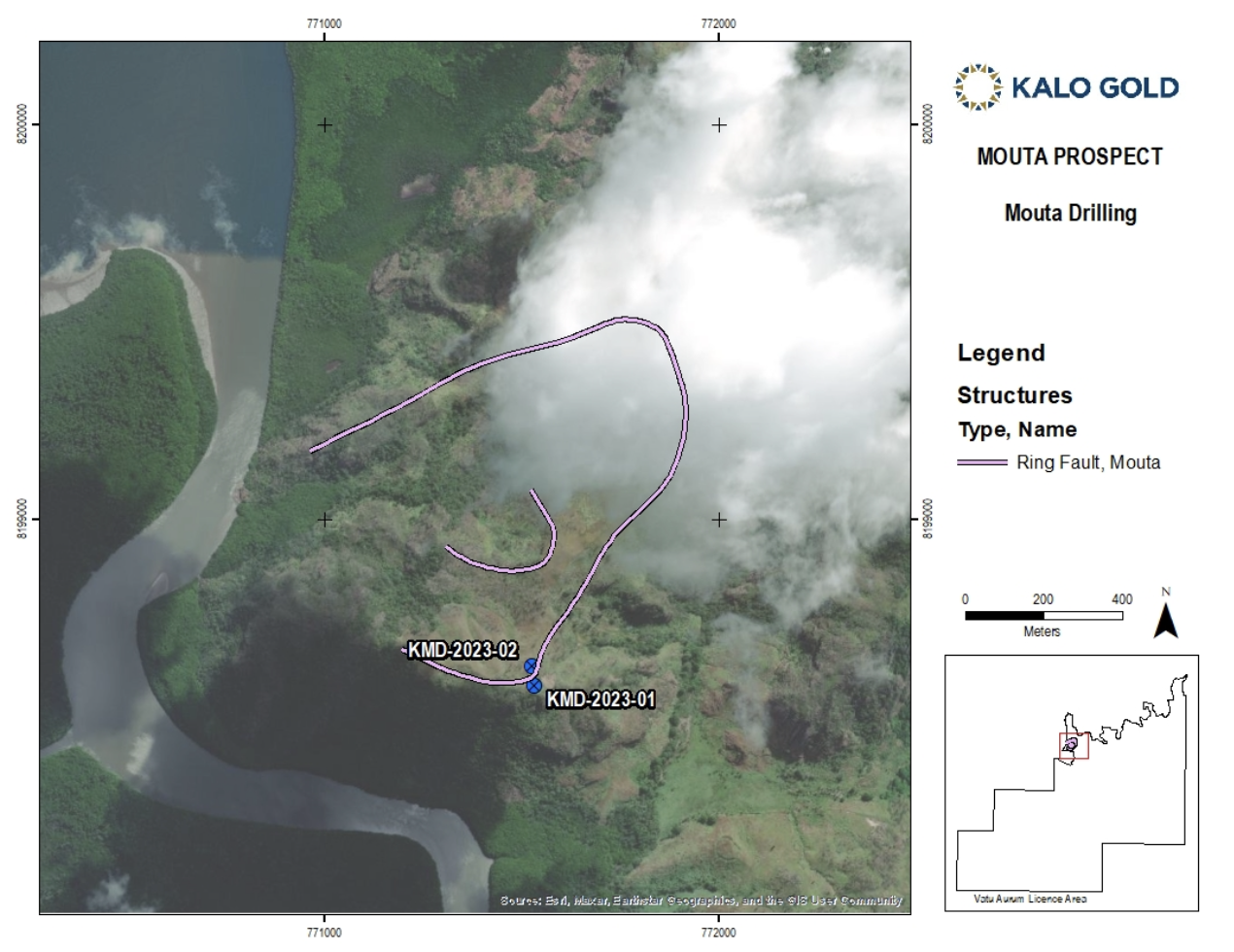
Figure 4: Vatu Aurum Gold Project – 2023 drilling to date (blue circles) at Mouta Prospect.
